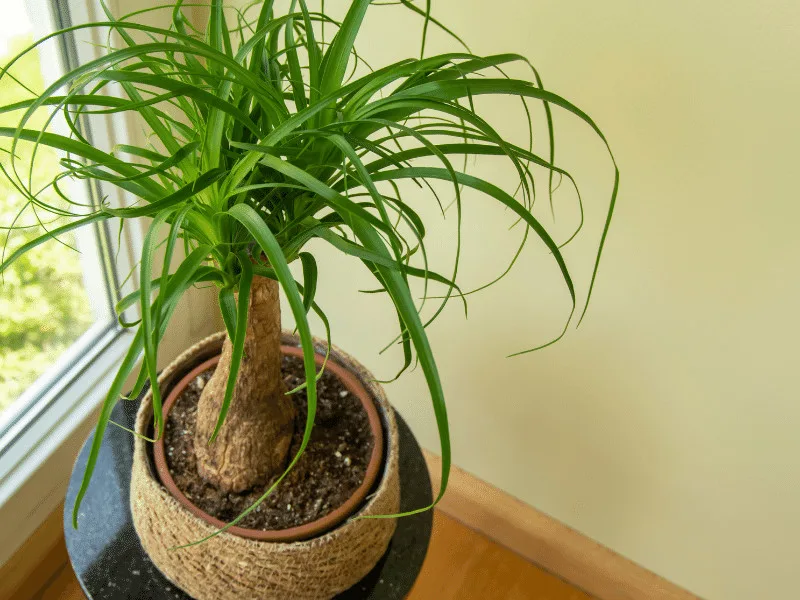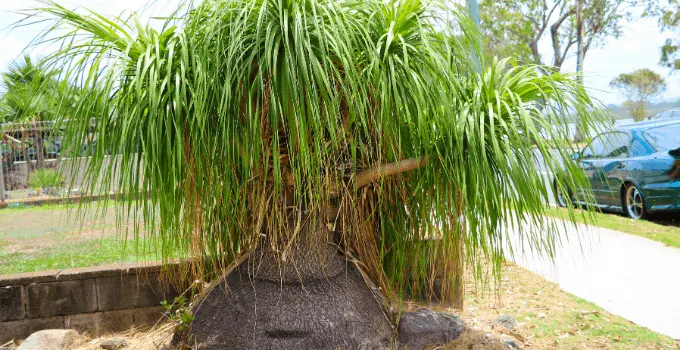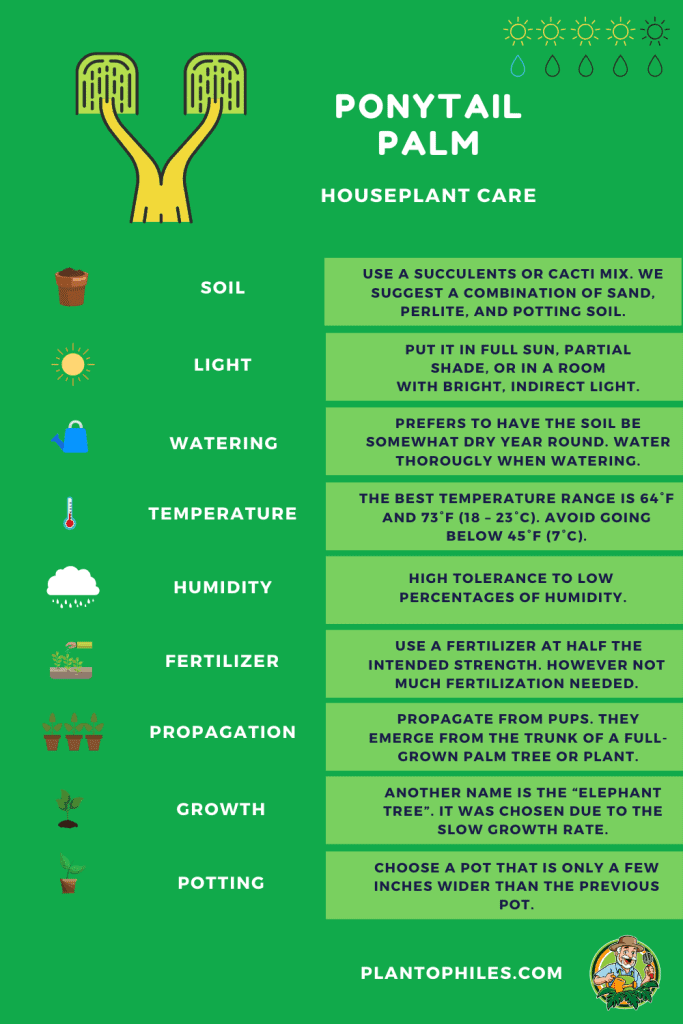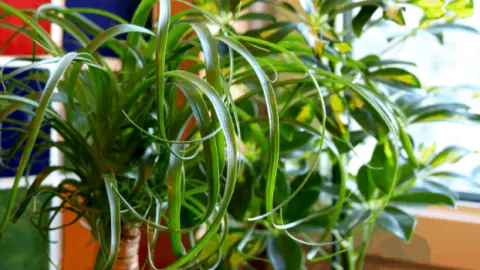In this article, I write about ponytail palm care as an indoor plant.
Ponytail Palm is the common name for Beaucarnea recurvata. It is part of the succulent family Asparagaceae according to the University of Florida. The Asparagus Family contains plants such as agave and yucca. This plant stores water in its bulbous trunk.
Just like a tall subtropical tree, the ponytail palm plant has a central trunk with long, leathery green leaves cascading from the top.
These faux palms can be found in rather arid regions such as mountain ranges and cliffs where there is plenty of rocky soil.
Their natural habitat is southeastern Mexico. They grow anywhere from 100 to 2,800 meters above sea level.
The ponytail palm is relatively hardy, making it an ideal houseplant. They also tend to be slow growers. This article is based on my personal experience and care for a Ponytail palm.
Table of Contents
Ponytail Palm Takeaways
| Species | Beaucarnea recurvata |
| Synonyms | Ponytail palm, B. recurvata var. stricta, Nolina recurvata, Dasylirion recurvatum, elephant's foot palm, bottle palm |
| Family | Asparagaceae |
| Genus | Beaucarnea |
| Growth | Evergreen shrub |
| Height | 8 feet |
| Width | 5 feet |
| Soil | Well-draining succulent potting mix |
| Watering | Water every 21 to 28 days |
| Light | Bright indirect |
| Temperature | 60 to 80°F |
| Humidity | 40-50% |
| Fertilizer | Fertilize 2 times per month |
| Propagation | Plantlets |
| Toxicity | Non-toxic to humans and pets such as cats and dogs |
Care for a Ponytail Palm
The ponytail palm prefers bright light. Provide it with a well-draining succulent potting mix. Water every 3-4 weeks. The ideal temperature range is between 60-80°F (16-27°C). A humidity of 40-50% is sufficient. Fertilize twice a month in spring and summer.

How to Grow Ponytail Palm
(Find a full care sheet at the end of this article)
Soil
A potting mix for succulents or cacti is ideal. The soil mix needs to be well-draining. Beaucarnea recurvata, like most succulents, does not like wet soil.
A potting soil combination consisting of sand, perlite, and potting soil is ideal.
Light
Provide a ponytail palm with bright indirect light. Avoid direct sunlight but place it in a bright spot in the house such as a south-facing window.
Signs that the plant is getting too much sunlight faded and yellow leaves as well as brown tips on leaves.
Watering
Water every 3-4 weeks. The ponytail palm plant prefers to have the soil be somewhat dry year-round. When you water Beaucarnea recurvata, fully saturate it so that the roots receive water before allowing the plant to dry out.
Temperature
The ideal temperature for Beaucarnea recurvata is 60-80 degrees Fahrenheit (16-27 degrees Celsius). You can grow them outside in USDA Hardiness Zones 9-12.
Not all that picky about the temperature, a Beaucarnea recurvata will thrive just fine in average indoor temperatures.
Anything below 45°F (7°C) can cause damage to the leaves. These plants do go through a period of dormancy during the winter months.
You can grow a bottle palm outside in the summer as long as temperatures do not go below 50°F.
Humidity
Humidity between 40-50% is sufficient for a ponytail palm. It is a succulent plant and does not need high humidity levels.
Fertilizer
Fertilize a ponytail palm twice a month during the growing seasons in spring and summer. Dilute the fertilizer to half-strength. Do not fertilize the plant when in bloom. Do not fertilize in autumn and winter.
Propagation
Propagate a ponytail palm using pups.
Pups, or offsets, are the baby plants that will emerge from the trunk of a full-grown plant. You can use this to your advantage and forego having to participate in any risky or tedious methods of propagation.
Growth
If grown outdoors, they can reach a height of about 8 feet and 5 feet in width. Indoors they only grow to be about 3 feet tall. Rare examples outdoors might even reach a height of 30 feet.
Another name that the Ponytail Palm plant is known by is the Elephant tree or Elephant’s foot palm. It was chosen due to the slow growth rate.
They remain small if kept in a small pot, so give it room to grow by providing a bigger pot every 2 years.
Potting
Repot a Beaucarnea recurvata every 2 years.
The Ponytail Palm is relatively hardy and won’t lose leaves when transferred to a new container.
Use a clay pot if possible as it will soak up excess water.
The larger the pot, the larger the Ponytail palm will grow. But generally, only choose a pot that is a few inches wider than the previous pot when repotting.
Flowering
The blooms that occur on a Beaucarnea recurvate are quite unusual when compared to flowering specimens.
These flowers are extremely rare and emerge from the top of the plant as yellow, branchlike bracts.

Ponytail Palm Watering
A Beaucarnea recurvata is not a true palm but a succulent plant that can store water in its trunk and therefore needs to be watered according. Do not overwater as these plants will develop root rot.
In fact, they are considered to be drought tolerant. The typical Beaucarnea recurvate owner will water their plants every two to three weeks, sometimes even once a month depending on the environment.
If your home has higher levels of humidity, spread out watering schedules. Checking the soil is a good way to gauge how much moisture it needs. Only water when the top 2-3 inches of soil are completely dried out (5-7.5cm).
Propagate Ponytail Palm
Propagate the Ponytail palm in spring or summer through pup division.
Follow these steps:
- Take the parent plant that has produced shoots and gently dig out the entire plant around the base so that the new pups are exposed.
- Get a clean knife and make incisions to separate pups from the adult plant. Keep in mind that any young shoots with a length of about four inches will tend to root more quickly. You can also add rooting hormone to speed up the process.
- Place the newly divided pup shoots into the soil with cactus or succulent-based soil. There should be drainage holes located on the bottom of the container.
- Thoroughly water the plant before placing a bag over the top.
- Keep the covered pot and shoots in a room that gets lots of warmth.
- Continue misting along the soil’s surface until you see roots appear where you can then transfer it them to larger pots.
We also have an article about Yucca plant care. They are in the same family and the propagation process through pups is very similar.
Learn how to properly trim and prune your Ponytail palm.
Ponytail Palm Pests And Diseases
The ponytail palm plant is not very prone to pests. The most common pests that tend to go after the Elephant tree are spider mites, mealybugs, and scale insects.
They are also prone to diseases such as root and stem rot. A disease that will leave the plant with stunted growth.
Bugs that attack a Beaucarnea recurvata will show themselves on the leaves. They appear as black or white spots, while spider mites will produce webbing.
Using a hose with fairly hard pressure can wash them away. If this doesn’t work, use an insecticide. These can be bought at your local home improvement store.
You’ll want to consult with professionals to determine which insecticide to use.
They are also prone to diseases such as root and stem rot. A disease that will leave the plant with stunted growth.
They are easy to avoid if you know what to look for. Rot is typically caused by overwatering your plant.
Careful watering while allowing the soil to dry out can prevent this issue. If you do notice that your plant has saggy, mushy leaves or stems, you’ll have to take further action.
Cut off the infected parts, repot, and place the plant in a warm area so that it can dry out.
Ponytail Palm Plant Problems And Solutions
Brown Tips on Leaves
The most common reason for brown tips on leaves is underwatering and providing too much fertilizer. Tackle this problem by stopping the use of fertilizer. It will take about a week to see any improvements.
If that doesn’t work, increase the amount of moisture that you provide your Ponytail Palm plant. Water longer and deeper when watering.
Yellow Leaves
These plants are known for their green foliage. In the event that this color shifts to a yellow hue, you may be watering your Ponytail Palm too much.
Allowing your plant to dry out for a longer period of time between waterings may be the solution to your yellowing leaves problem.
Trunk Shriveling
The trunk is responsible for holding water. Displaying obvious shriveling is a good sign that you aren’t giving your plant enough moisture.
Gradually increase the amount of water until the trunk starts to repair itself.
Loss of Leaves
The leaves may, at some point, wilt and fall off the main rosette of foliage. This is due to overwatering.
Decrease the amount of water that you give your Ponytail Palm and wait some more time between your watering sessions.

Read about common Ponytail palm diseases.
5 Tips For A Thriving Ponytail Palm
- Keep the soil on the dryer end of the spectrum to avoid any root or stem rot!
- Place these floras into an area that receives plenty of bright, indirect light.
- Only fertilize 2-times a month in spring and summer
- Opt out of misting so that your plant can stay in low-level humidity.
- Repot every 2 years in a new container
Ponytail Palm Toxicity
The Ponytail palm is non-toxic to humans, cats, and dogs according to ASCPA.
Frequently Asked Questions
Can you cut back a ponytail palm?
You can cut back the foliage on a ponytail palm so that it looks presentable. Although not entirely necessary, doing this during the growing season is best,
How do I bring a ponytail palm plant back to life?
Start repotting the plant and removing any parts that have been infected by rot. You should also forego watering for a week since the problem was likely due to an abundance of moisture.
How long does a ponytail palm live?
These plants can live for more than 350 years if grown outdoors.

Read about what to do if your Ponytail palm is dying.
Conclusion on Ponytail Palm Care
To care for a ponytail palm provide:
- Light: Bright indirect light
- Soil: Well-draining succulent mix
- Water: Every 3-4 weeks
- Temperature: 60-80°F (16-27°C)
- Humidity: 40-50%
- Fertilizer: 2 times a month in spring and summer

Daniel has been a plant enthusiast for over 20 years. He owns hundreds of houseplants and prepares for the chili growing seasons yearly with great anticipation. His favorite plants are plant species in the Araceae family, such as Monstera, Philodendron, and Anthurium. He also loves gardening and is growing hot peppers, tomatoes, and many more vegetables.


